Dr. Jackie Gerstein has been teaching in-person and online for several decades. Currently, she teaches master’s level online courses in educational technology for Boise State, Walden, and Western Governors’ Universities as well as gifted elementary education where she focuses on STEM, STEAM, and Maker Education.
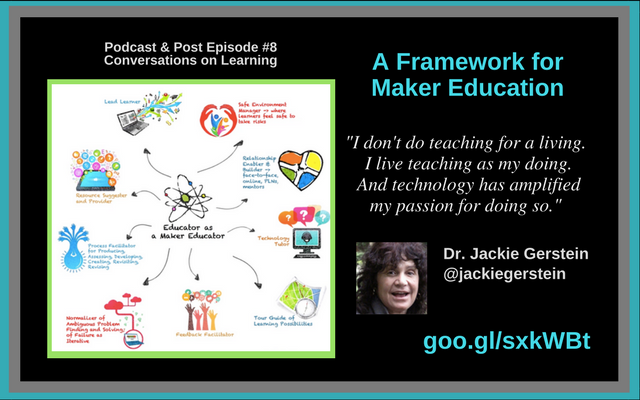
Podcast: Play in new window | Download
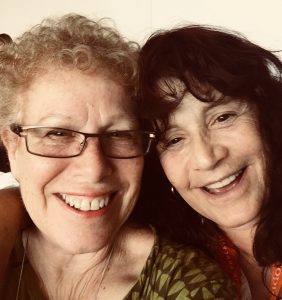 I was so lucky to present with Jackie at ISTE 2017 in San Antonio and participate in a webinar with her about maker education. I am constantly learning from Jackie and am always blown away by how much she knows and shares with the world. When Jackie agreed to have a conversation with me, we had to talk about maker ed and her life. I captured some of the conversations from the podcast and referred to references mentioned in her blog below.
I was so lucky to present with Jackie at ISTE 2017 in San Antonio and participate in a webinar with her about maker education. I am constantly learning from Jackie and am always blown away by how much she knows and shares with the world. When Jackie agreed to have a conversation with me, we had to talk about maker ed and her life. I captured some of the conversations from the podcast and referred to references mentioned in her blog below.
Can you share about you, your background, and how you decided to focus on maker education?
I was one of those painfully, bored kids in my K-12 education [ Freedom to Learn 2017]. I hated school and didn’t think it was fair. In college, I took a course in environmental education. For part of that course, we went out to the local camp where I worked with 5th and 6th graders for a week. We studied marine life by walking down a creek. To learn history, we went to a local cemetery and did gravestone rubbings to look at their lineage. This just made sense. It was real and kids were learning content. So I thought, “why wasn’t my education like this?” Maker education is just a form of experiential education and now I am thrilled that it is becoming very popular in schools and libraries right now.
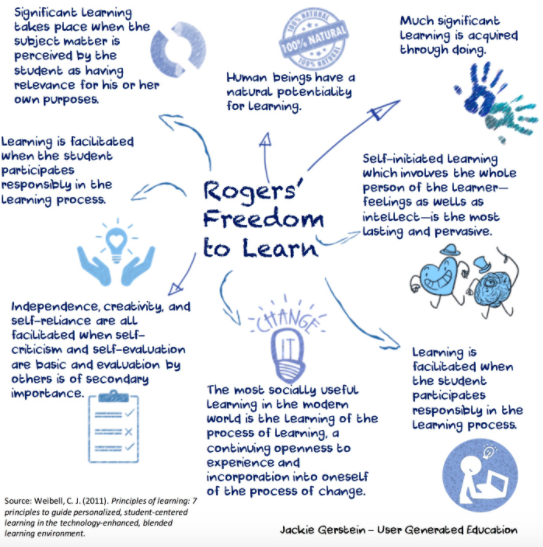
Why did you come up with A Framework for Maker Education?
Coming from the experiential ed field, it’s this idea that if we just have an experience, then we leave learning up to chance. It’s based on the experiential learning cycle where you do a front load by framing experience, doing the experience, then reflecting on the experience. The cycle is not anything new. I just tweaked it to be more modern day and applicable to Maker Ed, STEM and STEAM, and to include more technology.

How do you connect making with what kids are supposed to be learning?
When you give someone a worksheet, they are learning one skill that’s often no related to anything else. You and I have talked about learning in context. If you give a kid a sheet with just math problems, they don’t connect to anything else in their lives. So you’re spending that time on things kids will probably forget and often do because it doesn’t have a context they can relate to. When we do Maker and STEAM activities, it is so easy to go through them and say how you are addressing cross-curricular common core standards within the activities. The kids are excited because they are learning skills not only related to the standards that teachers are asked to address, they are learning how to talk to each other, how to present orally, how to work together in a team, how to be innovative, how to use their creativity, and addressing the standards. We have this huge list of things kids are learning from a one-hour activity versus one or two things they might have learned from that hour long worksheet. [Games or Worksheets]
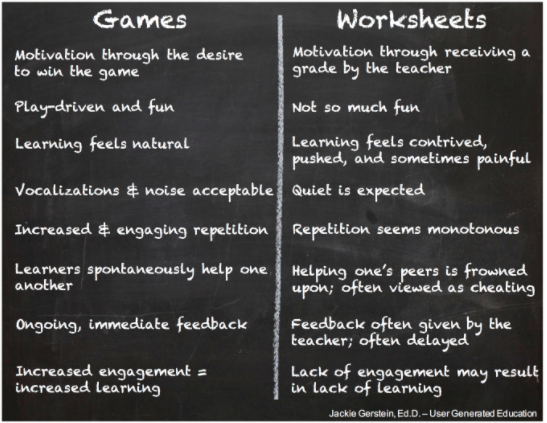
What is the connection with maker education and social-emotional learning?
I’m not a big fan of step-by-step activities where kids all end up with the same product. I call it the Thanksgiving Turkey where kids are all given a hand that they trace out on brown paper and stick on feathers. They all look the same except their name on the back. There are things like Gami-bots or different kinds of projects that are open-ended where kids can put themselves in them. By the nature of them being open ended instead of close-ended projects where all the products are the same, kids develop social emotional learning. I wrote a blog post “Helping Kids Move Beyond I Can’t Do This.”

I work with gifted elementary students and do summer camps for elementary kids. Almost every time with the nature of the projects, I hear “I can’t do this.” And that’s usually because it doesn’t work the first time exactly the way they want. It’s the same with worksheets where they get them right the first time or not and then the teacher moves on. They don’t have time to master it so they just move on. Even adults get frustrated about this because they didn’t have the experience of making something, having it fail, and trying multiple iterations around it. They aren’t developing the idea of what do I do when I’m frustrated or how to ask for help. I tell kids to ask another kid for help. In real life, there is no teacher there for them to ask for help. So they have to figure out ways to get the help they need. There is so much social-emotional learning happening in maker education. What they do with one project helps them with the next one.
How do you make reflection a powerful part of your framework?
I encourage my kids to blog. I might do a Twitter hashtag and a YouTube channel this year too. There are other ways to encourage them to reflect on their learning. I’m in a Title I school where I have kids with parents from Mexico so they’re not that comfortable with social media. I sent home a permission slip even though some parents may not have signed the AUP, they all give permission because they want to see the projects. I do Google photos for them so I take a lot of pictures. I never use kids’ names. You saw the videos of my kids. Even though you know where I live, you don’t know what schools. There are 19 elementary schools in my town and there is no mention of the names of the schools. There are lots of ways to get kids to reflect. I might have them create a comic strip, infographic, or photo essay and put those on their blogs. They love YouTube so if I start a YouTube channel, they’ll eat that up. So that involves Universal Design for Thinking® that offers different ways for them to reflect on their experiences. [Check Documenting and Reflecting on Learning]
How do you encourage your teachers to incorporate makerspaces in their schools?
Human beings like to make. Good teachers have always done making and experiential ed in their classrooms. Look at the teacher gardener in the Bronx who created hydroponic gardens and encouraged kids go to the Farmers Market to sell their goods. I had some of my college students encouraging empathy by doing a social studies project having their kids write in a journal about being one of the settlers as if they were on a journey. I hope that making doesn’t become just one more flavor of the month. If people associate making with only 3D printers and laser cutters, first, many schools cannot afford those, and second, teachers and librarians have said that’s not what they’re about. [The Classroom or Library as a Makerspace]
There are tools and resources that are affordable and useful like cardboard and play dough. I found out about activities and resources from social media. So I tell my ed-tech graduate students as well as my student teachers to follow hashtags like #makered, #STEM, and #STEAM. That’s where I found out about using pumpkin cutters for making and where to find them for low prices especially right after Halloween. We don’t all have to be reinventing the wheel. [Read Teacher PD: Purposeful Tinkering and Application]
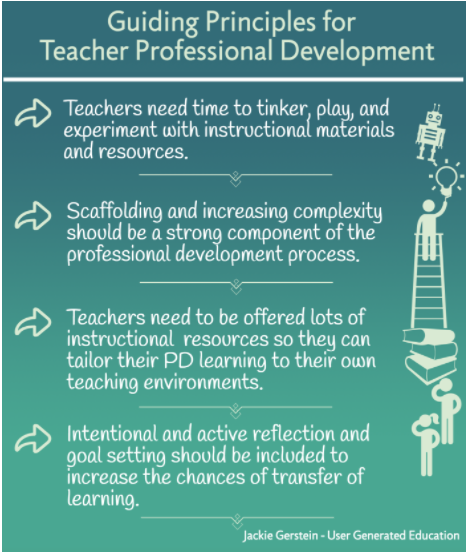
You share at https://usergeneratededucation.wordpress.com/. Can you talk about the importance of sharing?
It’s important to share. We talked about the idea that educators do not want to share out work. People have said to me, “but I’m not getting paid then for that work.” I always say that we get so much back for sharing. When you do share out, you get rewards from people coming up to you and thanking you. I’ve gotten jobs because I share my work. I think it is not about living in the Win-Lose model. Same thing with kids going back to the reflective piece I mentioned before, one of my beliefs is that kids should be sharing their work out to a broader audience. It motivates us. When someone comes up to me at a conference and tells me that they read my blog and it helps them, there’s no bigger reward than that.
Educators love sharing on social media. I never heard of squishy circuits and then I saw some links about using playdough or make your own. Then I got some LED lights and batteries at the dollar store. I have my kids interview each other to design an animal with squishy circuits for their classmates. I shared this out and a teacher may find a better idea or adds to this project then shares it with others. This then becomes a collective, cumulative sharing, and then everyone benefits. Teachers don’t have to reinvent everything or figure things on their own anymore.
Before we end the podcast, can you share some of the maker projects you are doing with kids?
I do different themes. The cardboard creations where we spent a week 3 hours a day. We did circuit camp. We did Toy Making and Hacking. This was probably one of my favorites. In the first part of the week, they make toys. In the second part, I bought a pile of old handheld games that you can get in lots from eBay. They take apart those games and you should see their looks when they take apart the circuit boards, screens, and keys.
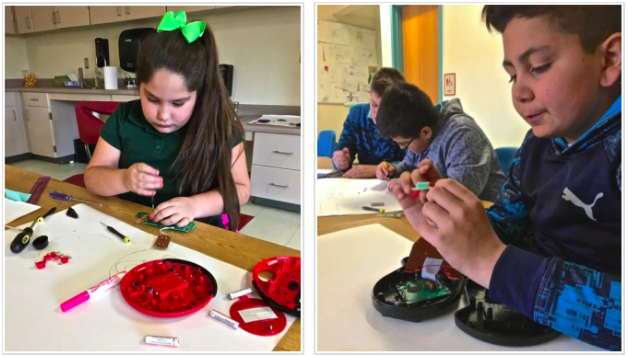
They have to invent a new game out of the parts and create a prototype that doesn’t have to be working. They have to create a poster board that says the name of the game, who it’s from, the rules, and designed an app for it so you get to see what it looks like. There are so many ways to bring maker ed activities into all environments.
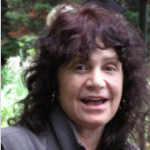 Dr. Jackie Gerstein’s byline is, “I don’t do teaching for a living. I live teaching as my doing . . . and technology has amplified my passion for doing so.” Dr. Gerstein has been teaching in-person and online for several decades. Currently, she teaches master’s level online courses in educational technology for Boise State, Walden, and Western Governors’ Universities as well as gifted elementary education where she focuses on STEM, STEAM, and Maker Education.
Dr. Jackie Gerstein’s byline is, “I don’t do teaching for a living. I live teaching as my doing . . . and technology has amplified my passion for doing so.” Dr. Gerstein has been teaching in-person and online for several decades. Currently, she teaches master’s level online courses in educational technology for Boise State, Walden, and Western Governors’ Universities as well as gifted elementary education where she focuses on STEM, STEAM, and Maker Education.
She believes that one of the roles and responsibilities of the 21st-century educator is to share resources, ideas, and instructional strategies with other educators.
Jackie actively blogs at https://usergeneratededucation.wordpress.com/ and tweets at https://twitter.com/jackiegerstein
Resources
- https://www.slideshare.net/jgerst1111/workshop-maker-education-in-a-context?qid=51f75f03-c038-436f-99b1-5f6d537f46c4&v=&b=&from_search=1
- Youtube Video commercial for my SXSW EDU proposal – https://www.youtube.com/watch?v=ADabjmV8qBE
- The Educator as a Maker Educator (Kindle version) https://www.amazon.com/Educator-as-Maker-ebook/dp/B016Z5NZ6O/
Some articles about Jackie’s maker education framework
- Don’t Leave Learning Up to Chance: Framing and Reflection https://ww2.kqed.org/mindshift/2016/09/14/dont-leave-learning-up-to-chance-framing-and-reflection/
- Fashioning a Framework for Maker Education — THE Journal https://thejournal.com/articles/2017/05/16/fashioning-a-framework-for-maker-education.aspx
*****
Interested in checking out more of the Rethinking Learning podcasts and reflections, click on the podcast tab at the top, the logo below, or go to https://barbarabray.net/podcasts/
For more information about Barbara’s book, Define Your WHY, go to this page or click on the image of the book for resources, questions, and links.






